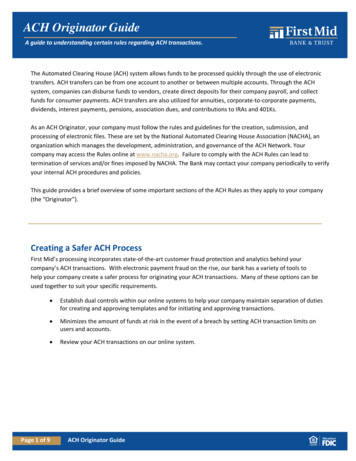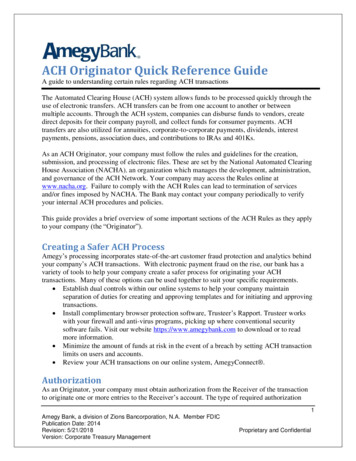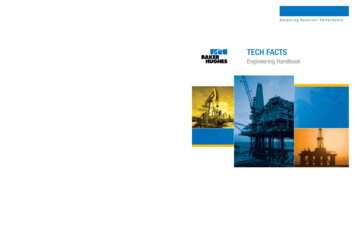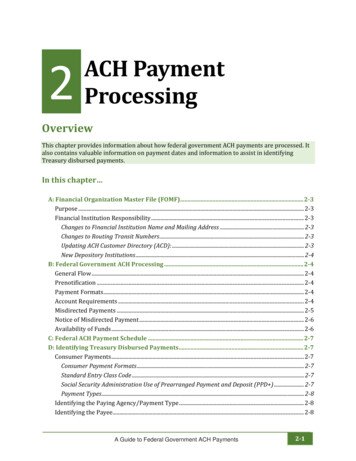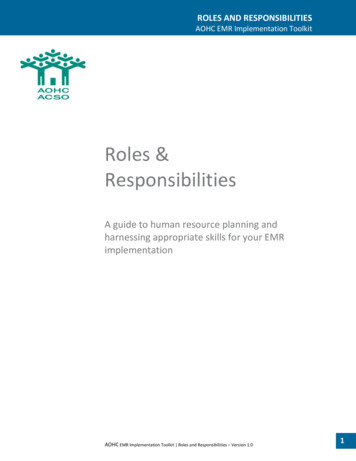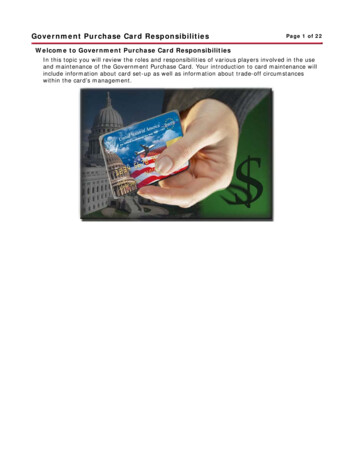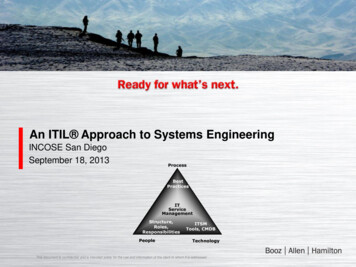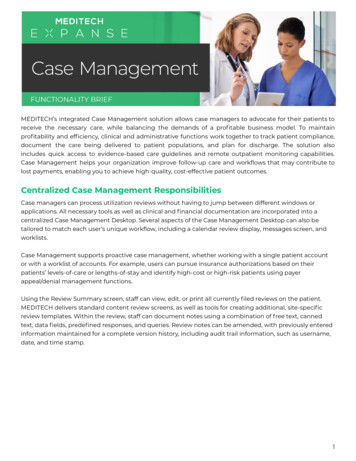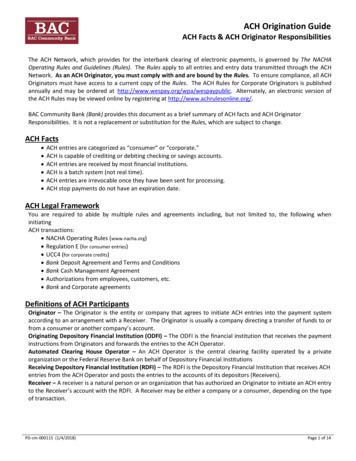
Transcription
ACH Origination GuideACH Facts & ACH Originator ResponsibilitiesThe ACH Network, which provides for the interbank clearing of electronic payments, is governed by The NACHAOperating Rules and Guidelines (Rules). The Rules apply to all entries and entry data transmitted through the ACHNetwork. As an ACH Originator, you must comply with and are bound by the Rules. To ensure compliance, all ACHOriginators must have access to a current copy of the Rules. The ACH Rules for Corporate Originators is publishedannually and may be ordered at http://www.wespay.org/wpa/wespaypublic. Alternately, an electronic version ofthe ACH Rules may be viewed online by registering at http://www.achrulesonline.org/.BAC Community Bank (Bank) provides this document as a brief summary of ACH facts and ACH OriginatorResponsibilities. It is not a replacement or substitution for the Rules, which are subject to change.ACH Facts ACH entries are categorized as “consumer” or “corporate.”ACH is capable of crediting or debiting checking or savings accounts.ACH entries are received by most financial institutions.ACH is a batch system (not real time).ACH entries are irrevocable once they have been sent for processing.ACH stop payments do not have an expiration date.ACH Legal FrameworkYou are required to abide by multiple rules and agreements including, but not limited to, the following wheninitiatingACH transactions: NACHA Operating Rules (www.nacha.org) Regulation E (for consumer entries) UCC4 (for corporate credits) Bank Deposit Agreement and Terms and Conditions Bank Cash Management Agreement Authorizations from employees, customers, etc. Bank and Corporate agreementsDefinitions of ACH ParticipantsOriginator – The Originator is the entity or company that agrees to initiate ACH entries into the payment systemaccording to an arrangement with a Receiver. The Originator is usually a company directing a transfer of funds to orfrom a consumer or another company’s account.Originating Depository Financial Institution (ODFI) – The ODFI is the financial institution that receives the paymentinstructions from Originators and forwards the entries to the ACH Operator.Automated Clearing House Operator – An ACH Operator is the central clearing facility operated by a privateorganization or the Federal Reserve Bank on behalf of Depository Financial InstitutionsReceiving Depository Financial Institution (RDFI) – The RDFI is the Depository Financial Institution that receives ACHentries from the ACH Operator and posts the entries to the accounts of its depositors (Receivers).Receiver – A receiver is a natural person or an organization that has authorized an Originator to initiate an ACH entryto the Receiver’s account with the RDFI. A Receiver may be either a company or a consumer, depending on the typeof transaction.PD-cm-000115 (1/4/2018)Page 1 of 14
ACH Origination GuideACH Facts & ACH Originator ResponsibilitiesHow Does the ACH Network Function?As the Originator, your company must first obtain authorization to initiate a transaction to the Receiver’s account orprovide notice to the Receiver that a transaction will be initiated to their account. Your company (Originator) thencreates a file of ACH transactions assigning a company name that is easily recognized by the Receiver. The file is thensent to your Originating Depository Financial Institution (ODFI), BAC Community Bank.The ODFI collects ACH files from Originator with which it has contractual relationships, verifies the validity of thesefiles and at specified times, transmits these files to the ACH Operator. The ACH Operator receives ACH files from theODFI , edits the file to make sure they are formatted properly and distributes files of entries to the ReceivingDepository Financial Institution (RDFI). The RDFI receives files of entries from the ACH Operator for its accountholders. Entries are posted based upon the Settlement Date and account Number. Periodic statements are providedto the Receiver with descriptive information about the ACH transaction, including the date of the transaction, dollaramount, payee (Originator) name, transaction description (i.e. Payroll, water bill).How Are ACH Funds Settled?Settlement is the actual transfer of funds between financial institutions to complete the payment instructions of anACH entry. The Federal Reserve Bank provides settlement services for ACH entries. The timing of settlement is basedupon the Effective Entry Date indicated on the ACH file and the time of its delivery to the ACH Operator. Yourcompany as the Originator will determine the Effective Entry Date of the file you send to your ODFI. This is the dateyour company intends the entries to post to the accounts of the Receivers (employees or customers). When the ACHOperator processes an ACH file, the Effective Entry Date is read and entries are settled based upon that date, knownas the Settlement Date. The Effective Entry Date in most cases is the same as the Settlement Date, but it is possiblethat the Settlement Date could be after the Effective Entry Date. For example, if the ACH Operator cannot settle onthe Effective Entry Date due to untimely file delivery, a stale date, weekend or holiday, the ACH Operator will apply aSettlement Date of the next business day.Your Responsibilities as an Originator as an Originator Obtain proper authorizations, dependent upon the transaction type, and retain authorizations for two yearspast revocation. If requested by the Bank, provide a copy of the authorization. The Bank may request to see yourauthorizations from time to time as part of an annual audit. Send entries on the proper date. Give appropriate notice to debtor if changing amount or date. Cease subsequent entries when notified. Make necessary changes to payee account information within three (3) banking days upon receipt of a Noticeof Correction or before another entry is sent. Check payees against OFAC compliance checklists. Protect the banking information received to originate transactions. Ensure your computer and you are protected as outlined in the Bank Cash Management Agreement. Ensure the Originator is clearly identified as the source of the ACH transaction. Specifically, populate theCompany Name Field of the NACHA formatted file with a name known to and readily recognized by theReceiver of the entry.PD-cm-000115 (1/4/2018)Page 2 of 14
ACH Origination GuideACH Facts & ACH Originator ResponsibilitiesDirect Deposit Payroll Authorizations (Consumer) Authorizations (Consumer) Use a direct deposit authorization form that collects employee account information. This form should allowthe company to make credit and debit entries in the event a payroll adjustment is necessary. Obtain a voided check from the employee (if possible). The most common SEC code for direct deposit is PPD.Consumer Debit Authorizations Debit Authorizations For consumers, an authorization to debit an account must be in writing or “similarly authenticated.” The most common SEC code for consumer debits is PPD.Corporate Authorizations Authorizations For companies, there must be a record of an agreement between the two parties. The most common SEC codes for corporate transactions are CCD or CTX, depending upon addendaorigination. It is used for debits and credits.Changing Date or Amounts of Debits or Amounts of Debits ACH Rules require you to notify your debtors of any changes in date or amount debited under the followingcircumstances:1. Seven (7) calendar days notice for a change of date (consumer and corporate).2. Ten (10) calendar days notice for a change in amount (consumer only). Sending the notice via U.S. Mail is acceptable.Prenotifications (Prenotes) Prenotes are zero-dollar entries that precede the first live entry. The purpose of a prenote is to verify accountinformation.Prenotes are optional for you to send. However, if sent, prenote rules must be followed and a prenote mustprecede the first live entry by at least three (3) banking days.The Receiving Bank is not required to validate the name of the payee on the prenote, although many do; theyare only required to check the account number.PD-cm-000115 (1/4/2018)Page 3 of 14
ACH Origination GuideACH Facts & ACH Originator ResponsibilitiesNotice of Change (NOC) NOC is created by the Receiver’s financial institution to notify the originator (via the Bank) that:1. Previously valid information in an ACH entry (Direct Deposit/Direct Payment) is now outdated, andneeds to be changed2. Information in an ACH entry (Direct Deposit/Direct Payment) is erroneous, and needs to be corrected. The Bank will notify you of any NOCs received on your behalf. ACH Rules require the originator to make changes or corrections within three (3) banking days of receiving theinformation from the Bank or before another entry is sent. The Receiving Bank warrants that the Information they provide to you is correct. The Bank may pass along any fines received based upon your non-compliance. The Originator has the option of responding to NOCs for Single Entry (non-recurring) payments. This applies tothe following SEC Codes only: ARC, BOC, POP, POS, RCK and XCK entries, as well as, TEL and WEB entriesbearing a single entry indicator (“S” or “blank” for TEL and “S” for WEB).Notification of Change (NOC) Codes (most common)NOC CodeReasonC01Account NumberC02Transit/Routing NumberDue to a merger or consolidation, a once valid routing numbermust be changed.C03Transit/Routing Number andAccount NumberDue to a merger or consolidation, a once valid transit/routingnumber must be changed and the account number structure is nolonger valid.C04Account NameC05Transaction CodeTransaction code is incorrect and this is causing the ACH entry tobe routed to the wrong application (demand or savings).C06Account Number andTransaction CodeAccount number is incorrect or is formatted incorrectly and thetransaction code is incorrect causing the ACH entry to be routed tothe wrong application (demand or savings).C07Transit/Routing Number,Account Number andTransaction CodeDue to a merger or consolidation, a once valid transit/routingnumber must be changed, the account number structure is nolonger valid and the transaction code is incorrect causing the ACHentry to be routed to the wrong application (demand or savings).C09Individual IdentificationNumberThe individual id number was incorrect.C13Addenda FormatPD-cm-000115 (1/4/2018)DescriptionAccount number is incorrect or is formatted incorrectly.Customer has changed name.Information in the Entry Detail Record was correct and the entrywas processed and posted by RDFI. However, information found inthe addenda record was unclear or was formatted incorrectly.Page 4 of 14
ACH Origination GuideACH Facts & ACH Originator ResponsibilitiesReturns Returns must be processed by the Receiving Bank within 24 hours of settlement. Returns that areunauthorized beyond the 24 hours are the company’s liability and any disputes may have to be settled outsideof the banking network. Review your account activity daily. An exception to the 24-hour rule is consumer unauthorized returns, which may be returned within 60 days ofposting. The use of consumer (PPD) or corporate (CCD) entry codes determines the applicable ACH return rules. If the Receiving Bank receives a dispute claiming a debit was unauthorized, the Receiving Bank must get asigned Written Statement of Unauthorized Debit from the account holder. You may obtain a copy of thatstatement by requesting a copy through the Bank. You may re-initiate a debit entry up to two times if (1) the entry has been returned for insufficient oruncollected funds (Return Reason Code R01 and R09), (2) the entry has been returned for stopped payment andreinitiation has been authorized by the Account Holder, or (3) the Bank has taken corrective action to remedythe reason for the return. A “Stop Payment” return may be re-initiated only if you receive approval from the payee to re-send the item. It is a violation of NACHA Rules to re-initiate the debit entry if a return is received for any other reason. Disagreements regarding authorization should be handled OUTSIDE of the ACH NetworkOriginators must maintain a return rate below .5% for entries returned as unauthorized.Originators can have no more that 3% of your total debit entries returned due to administrative oraccount data errors.Originators can have no more than 15% of your total debit entries returned for any return reason.PD-cm-000115 (1/4/2018)Page 5 of 14
ACH Origination GuideACH Facts & ACH Originator ResponsibilitiesReturn Entry Codes (most common)Reason for ReturnAction by OriginatorAvailableSEC CodesReturn DeadlineR01 – Insufficient FundsOriginator may initiate a new ACH entry within 180 days oforiginal Settlement date.Originator must stop initiation of entries and obtain anauthorization from the Receiver for another account.Originator must stop initiation of entries and contact theReceiver for correct account information.Originator must stop initiation of entries until accountnumber / structure is corrected.ALL24 HOURSALL24 HOURSALL24 HOURSALL24 HOURSR05 – Unauthorized Debit toConsumer Account UsingCorporate SEC CodeOriginator must stop initiation of entries.CCD. CTX60 Days – WrittenStatement of UnauthorizedDebitR06 – ODFI Request for ReturnR07 – Authorization RevokedOriginator must accept requested return.Originator must stop initiation of entries until new consumerauthorization is obtained.ALLPPD, TEL,WEBNot Applicable60 Days – WrittenStatement of UnauthorizedDebitR08 – Payment StoppedOriginator must contact Receiver to identify the reason forthe Stop Payment and obtain authorization beforereinitiating the entry.Originator may initiate a new ACH entry within 180 days ofthe original Settlement Date.ALL24 HOURSALL24 HOURSOriginator must stop initiation of entries.ARC, BOC,POP, PPD,TEL, WEB60 Days – WrittenStatement of UnauthorizedDebitR12 – Account Sold to Another DFI Originator must stop initiation of entries and obtain correctrouting number information for initiation of subsequententries.ALL24 HOURSR16 – Account FrozenOriginator must stop initiation of entries.ALL24 HOURSR20 – Non Transaction AccountR24 – Duplicate EntryOriginator must stop initiation of entries.Originator should accept the return. If the entry has alreadybeen reversed, Originator should contact the RDFI todetermine a solution. An Originator may reverse anerroneous or duplicate ACH entry/file up to 5 banking daysafter the Settlement Date of the entry/file. OR it mayrequest the RDFI to send a return.Originator must stop initiation of entries until subsequentauthorization has been obtained.ALLALL24 HOURS24 HOURSCCD, CTX24 HOURSR02 – Account ClosedR03 – No Account / Unable toLocateR04 – Invalid AccountR09 – Uncollected FundsR10 – Customer Advises NotAuthorized, Notice Not Provided,Improper Source Document, orAmount of Entry Not AccuratelyObtained from Source DocumentR29 – Corporate CustomerAdvises Not AuthorizedPD-cm-000115 (1/4/2018)Page 6 of 14
ACH Origination GuideACH Facts & ACH Originator ResponsibilitiesReversals If a reversing entry must be made, please consult the ACH Manager User Guide or contact Customer Servicefor instructions. Reversals may only be made for the following three conditions:1. wrong dollar amount2. wrong account number3. duplicate transaction When initiating a reversal, the reversing entry must be for the full amount, must be sent within five (5)banking days of original entry and must be sent within 24 hours of discovering the error. The Receiving Bank is under no obligation to post the reversing debit if it overdraws the payee’s account or ifthe payee’s account is closed. A payee must be notified if a reversing entry debits his or her account. However, a payee does not need toauthorize the reversing debit. The word “REVERSAL” must be placed in the Company Batch Header Field and if the file is reversing anerroneous file, then a correcting file must be initiated with the reversing fileOFAC (Office of Foreign Asset Control) (Office of Foreign Asset Control) You are required to check payees against OFAC compliance checklists. OFAC lists countries, groups and individuals with which U.S. Companies are not permitted to send or receivefunds. The Bank must protect itself by informing every client that it is against the law to send debit or credit entriestoOFAC-blocked entities. You may check the OFAC SDN list at: http://sdnsearch.ofac.treas.govPD-cm-000115 (1/4/2018)Page 7 of 14
ACH Origination GuideACH Facts & ACH Originator ResponsibilitiesWhat is an ACH Application (SEC) Code?ACH applications are payment types used by Originators, such as your company, to identify ACH debit and/or creditentries transmitted to a corporate or consumer account at the RDFI. Each ACH application is identified andrecognized by a specific Standard Entry Class (SEC) code, which appears in the ACH record format. The SEC code alsoidentifies the specific record layout that will be used to carry the payment and payment-related informationStandard Entry Class (SEC) CodesStandardTitleEntry Class(Sec) CodeTransaction TypeAccount TypeRequiredAgreement Or AuthorizationReference - NACHAOperating Rules andGuidelines (Rules)PPDPrearrangedPayment andDepositCredit or DebitSingle or Recurring EntryConsumerIn writing and signed for Debits.Section V - Chapter 45CCDCorporate Creditor Debit EntryCredit or DebitSingle Recurring EntryNon-ConsumerAgreement betweenOriginator and ReceiverSection V - Chapter 39ARCAccountsReceivable EntryDebit Single EntryConsumer orNon-ConsumerWritten NoticeSection V - Chapter 37BOCBack OfficeConversion EntryDebit Single EntryConsumer orNon-ConsumerPosted Notice and WrittenNoticeSection V - Chapter 38CIECustomerInitiated EntryCredit Single EntryConsumerOriginatedAgreement betweenOriginator and ReceiverSection V - Chapter 40CTXCorporate TradeExchangeCredit or DebitSingle or Recurring EntryNon-ConsumerAgreement betweenOriginator and ReceiverSection V - Chapter 39POPPoint-of-PurchaseEntryDebit Single EntryConsumer orNon-ConsumerPosted Notice and in writingand signed or similarlyauthenticatedSection V - Chapter 44POSPoint-of-SaleEntryDebit Single EntryConsumerIn writing and signed orsimilarly authenticatedSection I - Chapter 1RCKRe-presentedCheck EntryDebit Single EntryConsumerPosted NoticeSection V - Chapter 46TELTelephoneInitiated EntryDebitSingle or Recurring EntryConsumerOrally authorized overtelephoneSection V - Chapter 47WEBInternetInitiated/MobileEntryDebitSingle or Recurring EntryConsumerIn writing and signed orsimilarly authenticatedSection V - Chapter 48Orally or other written or nonwritten means for Credits.Proper Use of SEC CodeThe ODFI warrants that every transaction complies with the Rules. Specifically, Subsection 2.4.1.2: The EntryComplies with The Rules, and states “The Entry Complies with these Rules, including the use of the proper StandardEntry Class Code.” Another major concern is that these entries may be returned for an extended period of time,typically not afforded CCD or CTX entries posting to non-consumer accounts.PD-cm-000115 (1/4/2018)Page 8 of 14
ACH Origination GuideACH Facts & ACH Originator ResponsibilitiesWhat are the Fraud Risks for ACH?ACH Origination fraud is a challenge for Financial Institutions and ACH Originators like your company. In oneorigination system hacking scheme, perpetrators hack into the originator’s (your company) computer system usingcompromised User IDs and passwords and originate ACH credits to “mule” accounts created for the express purposeof committing fraud. Those accounts are then emptied and abandoned. The true originator’s account (your account)is debited for the invalid origination file. The credits are usually irretrievable by the time the fraud is discovered. Theoriginator’s credentials may have been compromised by an insider within the organization or stolen through keyloggers or Trojan Horse programs on the compr
ACH Rules require the originator to make changes or corrections within three (3) banking days of receiving t
